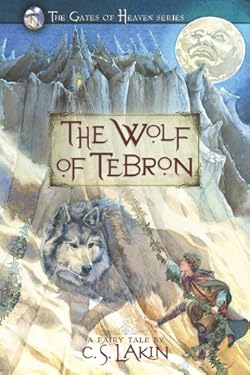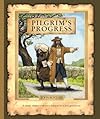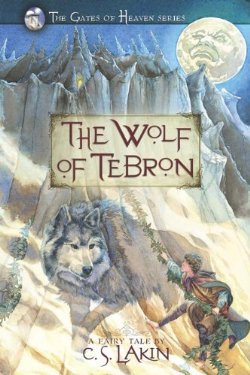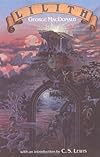The Wolf of Tebron by C.S. Lakin — A Full Review

Welcome to the first Christian Science-Fiction & Fantasy Blog Tour of 2011! The book of the month is THE WOLF OF TEBRON by C.S. Lakin.
First off, I want to give my kudos to the AMG cover designers. I just finished reviewing SWORD IN THE STARS, another recent AMG release, and both covers have this incredible pearlescent silver-golden glow. I don’t know how they do that, and though I’ve never seen it on a book before, it’s really cool looking!
OVERVIEW
The plot is more complicated than this, but here is the description from Amazon.
A young blacksmith must undertake a perilous journey to the four ends of the world to rescue his wife, who is held captive by the Moon. Along the way, he befriends a powerful wolf who encourages, protects, and ultimately sacrifices his life to save his human friend. A stirring allegory of Gods love in classic fairy tale tradition.
I’ll get into more plot details below.
THE AUTHOR
Again, the description from Amazon:
Susanne C. S. Lakin comes from a family of successful writers. She grew up collating television scripts for her mother, a screenwriter, story editor, and producer for television. As an adult, Susanne assisted in developing series for television, and while raising two daughters and running a bed and breakfast inn in northern California, wrote her first three novels and a cookbook.
In 2009, Susanne’s contemporary novel, Someone to Blame won the Zondervan First Novel contest at the Mount Hermon Christian Writers Conference. The novel will be published by Zondervan in August of 2010. She and her husband, Lee Miller, continue to live in California, where she currently works as a freelance copy editor and writing mentor.
THE PLOT
Yes there are some spoilers below, but I’ll try to be careful.
The book describes itself as a “literary” fairy tale (p.249), and I think this is true. It is more about the inner-journey of Joran while he goes to rescue his wife, Charris.
While the outward journey appears to be the main thing, it increasingly becomes apparent that Joran is his own worst enemy. The book makes the “Moon” out to be the bad guy, but really, the Moon hardly does anything. Joran must overcome his own emotions to win his wife back … as simple as that, or as difficult, depending how you look at it.
Overall, the book is more of an allegory in a fairy-tale’s clothing. Personally, I don’t mind light allegories, but this was a strong allegory, and that gave me some difficulty as I read the book.
THE ALLEGORIES
The problem with allegories is that a reader can take them too far, and I think that is a danger in reading THE WOLF OF TEBRON. I recommend reading it with the attitude of only lightly touching the mind on the allegories.
This is also true of other allegorical fiction … even THE CHRONICLES OF NARNIA. For instance, if you understand that Aslan represents Christ:
- He died for Edmund’s sins upon the stone table, representing the cross.
- He created the world, similar to Colossians 1:15ff.
But don’t take it too far … if so one might conclude from a partial reading of the Chronicles of Narnia that C.S. Lewis is a Monist and doesn’t believe in the Trinity. Where is God the Father in many of the books of the Chronicles of Narnia?(*) Where is God the Holy Spirit in all books except The Horse And His Boy?(*) I don’t think C.S. Lewis intended his allegorical parts to be looked at too deeply … certainly not in any one book taken alone.
(*) John Otte corrected me that Aslan is called the Son of the “Emperor-Beyond-the-Sea”, and Fred Warren let me know that The Horse And His Boy has a place near the end where Aslan replies, “Myself” to Shasta in three different ways representative of the three Persons of the Trinity. Thanks, John & Fred!
And it is in this same spirit that I recommend THE WOLF OF TEBRON be read … lightly … for the enjoyment and encouragement that it can bring.
THE CENTRAL MESSAGE
However … and this is a bit of a big however … the central message of the book (spoilers here) is somewhat problematic for me. This is how I interpreted things:
Joran represents “every-man” … (meaning he is a stand-in for human race as individuals), or at least “every-Christian” in the sense that he is on a quest.
Charris, his wife, represents “grace” (which is what her name means in Biblical Greek). To me this allegory is the only thing that can explain why his wife proposes to Joran, rather than the other way around. Without that explanation, I can’t see much reason for that, as it would tend to confuse kids and served nothing in the plot.
Ruyah, the wolf, represents God. Personally, I have trouble with this one based on some of the things that happen in the plot. But if you look at this one very lightly, then okay, I can give it a pass.
Now … with these three allegories understood, then I see this message emerging:
Grace is given to man, but he can only embrace it after he overcomes, with God’s help, his anger, despair, and fear.
The problem for me is that this seems to come more from a psychological view of salvation rather than a theological. I don’t see repentance here, for example.
If you take this message as a “part” of God’s salvation process, and not the whole, then there are truths that can be gleaned here. Just don’t read THE WOLF OF TEBRON like it’s a theological text. It wasn’t intended as such, in my opinion, but rather, as the author says:
I wrote THE WOLF OF TEBRON in order to portray God in a way that captures his love and devotion to our personal growth and salvation.
Again … and again … read the book lightly, and I think you will enjoy it. I did enjoy it when I didn’t try to think too deeply.
As this is aimed at the young adult market, I really don’t know how it will be received. Some kids can think deeper than adults, while others won’t care in the least about such things and will just look at the surface story.

THE CRAFT
A few minor (and I mean minor) recommended improvements:
The “Contract” With The Reader … the prologue told me “this is a book filled with action”, but it was generally not so. It was mostly Joran’s inward-journey. Yes, about page 200 some more action finally occurred, but this was late, and short lived.
Grammar … The word “AND” seemed to be missing here and there, page 37 being an example:
It took all his strength to get up each morning, milk his goat, prepare a tasteless breakfast.
Eye Movement … The author could improve spots here and there by consciously moving the reader’s eye through a description. For instance, on page 10 was the following sentence:
Bleeding heart vines trailed like a messy braid of hair down the cracks of the cliff from the castle atop the bluffs.
Do you see the problem? My eye starts at the vines and goes down but then I am jerked back to the cliff … and then jerked up further to the castle at the top. The verb “trail” makes the eyes in my brain want to go downward, but I am pulled the opposite direction.
Here are some excellent things I saw:
Careful Research … as someone who has done some blacksmithing, I thought that the descriptions of the trade were very accurate, and showed that the author investigated things carefully. This gave me confidence in the author.
Humor … I loved the part about the wolf eating “invisible chickens” on page 10. This was a great touch of humor, and I found many more scattered throughout the novel.
Foreshadowing … I really liked how the communication with the bird Bryp foreshadowed what was going to happen with Ruyah, the wolf. This “planting” helped make the entire story more believable, and was handled excellently.
Detail … the funny thing is that I had a negative example of this at first, but then changed my mind. On page 71, the Moon’s sister is described as living in a house with “the messiest kitchen [Joran] had ever seen.” I was like … how messy? Describe it … please!
Well, I didn’t have long to wait. On page 72, the fun description came:
As the woman busied herself at the stove, stirring an enormous copper kettle, Joran looked around him. Moon globes glowed dimly from the walls, and moonlight streamed in through a round window down the hall. Trinkets and bottles and tins lined cupboard shelves. Unlabeled glass jars of different shapes and colors cluttered the counter-tops, dirty dishes lay piled in the wash basin, oddities and sculptures crammed every nook. giant vultures of bronze glared from the walls; strange creatures with tentacles and buggy eyes hung from ornate chandeliers. A stack of moldy books, topped with what looked like a set of antlers, teetered precariously on a stool in the corner.
COMPARISONS TO OTHER BOOKS AND AUTHORS
I would almost call THE WOLF OF TEBRON a cross between George MacDonald’s LILLITH and John Bunyan’s PILGRIM’S PROGRESS.
 If you haven’t read LILLITH, then you should (but be aware that I have some serious theological issues with the book). It is probably the strangest Christian allegory you will ever read.
If you haven’t read LILLITH, then you should (but be aware that I have some serious theological issues with the book). It is probably the strangest Christian allegory you will ever read.
THE WOLF OF TEBRON isn’t that strange, but there were parts where I had to cock my head to the side and say “huh?”.
MY RECOMMENDATION
This is appropriate for young teens on up who enjoy the fantasy or fairy-tale genre. Their mileage may vary, however, but I think most will enjoy the novel if they can look beyond the few shortcomings I have pointed out.
VISIT THE OTHER CSFF BLOG TOUR MEMBERS
Disclaimer: In conjunction with the CSFF Blog Tour, I received a free copy of this book from the publisher.


C.S.,
Thanks for stopping by and letting me know your thoughts. Don’t take my reaction as anything typical … I have a Biblical and Theological studies degree and so tended toward over analyzing these kinds of things. I had to keep telling myself not to do that, and I don’t think others will get so deep.
I really do think the example of Ruyah caring for Joran was a powerful metaphor for God’s love for us, and that came across well.
On the writing style … I have found that I myself tend to skip AND’s in my writing here and there, and so it stood out to me since I’m trying to catch myself and avoid doing that. I think it comes from a true, oral story-telling voice, and that can be authentic … I just had to relax about it and try to hear the voice behind the text.
Thanks again, and God’s blessings on your novels!
-Robert
Great thoughtful review! I really enjoyed reading it! Like you I had a few issues with this book but thought it was well constructed.
Robert, I’ll be back later to comment more, but I thought I’d mention about the grammar thing, I use the “no add” style quite often too. It’s supposed to add emphasis, I think. I’ll have to look it up in Chicago Manual of Style to be sure. I mostly do it by feel. Sometimes the “and” disrupts the flow, I think. Anyway, I just thought I’d let you know, there are more of us “and-less” writers out there. 😉
Becky
Phyllis … I agree that the story was well constructed, as well as well-paced. It jumped ahead quite often, but the purpose was to move the story along, and that was good.
Rebecca … I never realized that “and-less” writing was an approved style by some. I found myself doing it but not knowing why, so I’ve been trying not to and eliminating the ones I find. One difference though is that I tend to not use commas in those cases, but rather make each one little sentences to indicate a longer pause, but I honestly must say I don’t know what I’m doing nor why.
Yeah, I see the and-less construction as mostly a rhythm thing, and in this case, I think it helps underscore the tedium it’s describing.
Grammar: I looked in Chicago Manual of Style and didn’t find a rule permitting the omission of the “and,” but in the serial comma rule, it says “When a conjunction joins the last two elements …” clearly indicating there are times when a conjunction does NOT join the last two elements.
I decided to explore the implications of genre in my post today rather than leaving a lengthy comment at every site that has taken a look at this. I appreciate your thoughts here, Robert.
Becky
Excellent post and discussion following. I thoroughly enjoyed reading your thoughts on this topic!
Thanks for stopping by, Julie, and thanks for taking part in the CSFF Blog Tour!